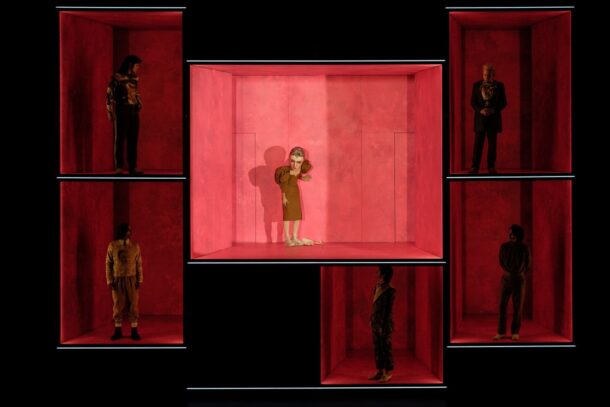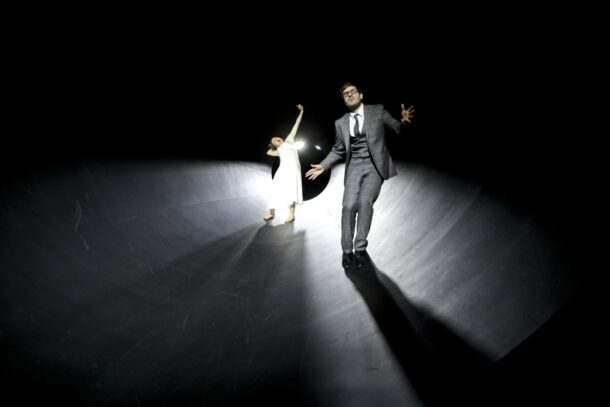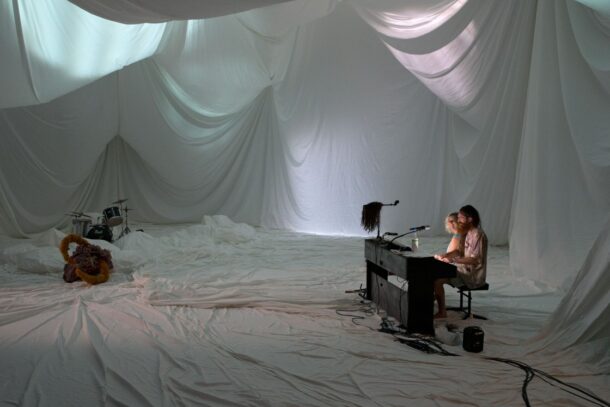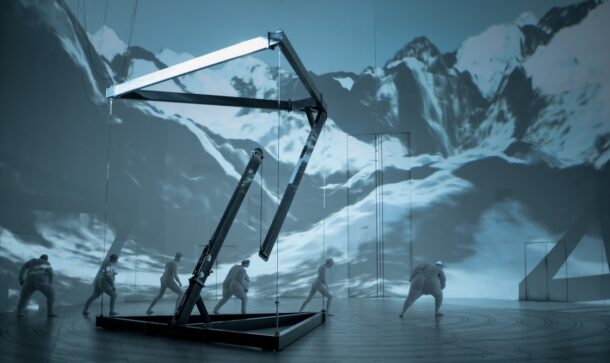By Steve Earnest
The 2021 Theatertreffen was once again presented under difficult circumstances due to the COVID-19 crisis that had plagued the world since Fall 2019. Productions were presented only via virtual format by the producing companies of the ten selected productions during May 2021. The Berliner Festspielehaus served as the central clearing house for the productions but viewing the productions was restricted by a few of the theatre companies and only brief time periods were given for viewing for reviewers outside of Europe. Several, though not all, of the productions will be covered by this review due to the guidelines established by the Theatertreffen and the individual theatre companies. Given the severe restrictions caused by world conditions, the results of the festival were uniformly outstanding and the staff at the Theatertreffen and the individual companies are to be highly commended.
One common element of the productions included in this review was that most, if not all of the productions, included video, sound and lighting crews co-mingling with the actors in large theatre spaces with no audiences. This approach made for a more cinematic treatment of the 2021 invited productions. However, the absence of audience response and presence in the actual theatres was notable. Many of the productions actually emphasized the bare theatres and film crews – these elements were interwoven into the production concepts. Empty seats without audience members could be utilized as staging areas and camera crews were often incorporated into the action of the works. Another trend of the past several years is the duration of works selected for the festival. Works lasting seven, eight and even twenty-four hours have been increasing in Germany for well over a decade and the scale of artistry has generally measured up to and warranted these expansive treatments of works presented on the various stages of the German-speaking world.
Maria Stuart was directed by Anne Lenk and produced by Schauspiel Zurich. The production was staged on a set that consisted of nine smaller stacked stages reminiscent of The Hollywood Squares game show from the 1970’s/80’s in the U.S. With three rows of three stages, the action unfolded stage by stage, with Elizabeth generally occupying the central, slightly larger stage area. Given the nature of the stage design, the actors communicated via direct address to the audience as they were unable, in most cases, to make eye contact with one another. There were several scenes where two actors would occupy a single square but for the most part each character was alone in their stage space. Centrally located, Elizabeth spent the first part of the work masked until the Fotheringay Park scene with Mary when her mask was removed. The overall style of the acting and look of the scenic design was reminiscent of a puppet show – the actors moved and behaved (even spoke) in a unique mannequin-like style. In that sense, the story of all the characters being “mere puppets to Elizabeth’s wishes” was developed. In addition to human puppets, Lenk’s staging and scenic design yielded the idea of jail cells in which Maria, Elizabeth (as well as the other characters) were confined or imprisoned in jail cells. (Note by the editor: Seeing this production later online I could not avoid associating the visual isolation of the characters in their cells with the now widespread phenomenon of zoom performance).

Maria Stuart, by Friedrich Schiller, directed by Anne Lenk. Photo: Arno Declair.
Der Zauberberg was a complicated production. Produced by Deutsches Theater Berlin, the work was based on the novel Der Zauberberg (The Magic Mountain) by Thomas Mann, but in fact, the work bore little in common with the novel, as the Sebastian Hartmann adaptation delved more into the difficult scenes that took place in the “Snow” chapter of the novel, set during several WW1 warfare scenes. Eventually arriving at a skiing location in the Swiss Alps, Der Zauberberg presented a world characterized by movement and time that had little to do with place. The ski lodge was the final destination for a number of individuals who had lost control and were nearly freezing to death; their interactions were frantic and tense and embodied the horrors of trench warfare during the dead of winter. Throughout the work, which was heavily based in movement and video imagery, the characters dealt with the issue of “time as a circular issue” and there were continuous strands of text that emphasized those passages, as repeated in the Hartmann adaptation. The actors embodied the difficult travel through the war-torn region, as lengthy circular movement sequences became a movement underscore to the spoken dialogue that was most often delivered by the lead character Castorp, played by Markwart Müller-Elmau. The most notable element of the production was the costumes. Designed by Adriana Brava Peretzki, the oversized body suits were intended to display the grotesqueness of human form. According to Peretzki, “I wanted the characters to move as objects rather than roles – the sick body is represented both internally and externally, no matter what condition it is in. And not hidden under clothing, but as a kind of disguise itself.” Produced on the main stage of the Deutsches Theater, the work made use of the entire auditorium, including the theatre seats and lobby. However, the central focus of the work was on the film crew and its ability to capture the extensive movement scenes from numerous camera angles as the bodies moved through the Alps on the completely white stage space. Multimedia filmic backgrounds of snowy mountains further developed the cinematic sequences.
Maria Schleef’s Name Her, produced by Ballhaus Ost Berlin, Munich Kammerspiele and Kosmos Theater, Vienna, was an incredible highlight of the festival. It featured Anne Tismer, a celebrated German actress who had appeared in numerous previous German films and stage plays, and here performed over forty female characters. Compiled by director/playwright Schleef, the female characters of Name Her were figures who had been neglected by history, which offered only limited information about the dynamic ideas, innovations and contributions they had provided to humanity. These figures ranged from scientists and professors such as Gudrun Penndorf, Josephine Nivison and Maria Gaetana, to composer Francesca Cacinni, Flora Tristan and many other important “unknown”women throughout history. The “lecture/demonstration” inspired work was presented in an exciting multi-screen environment that allowed Tismer the possibility of being seen on multiple screens simultaneously. In each of the scenes Tismer narrated the story of each character’s life and contributions as well as playing some scenes (utilizing a Brechtian “street scene” format) to develop two person scenes within the monodrama. All of the scenes were linked by the use of the 1990’s Madonna song “Like a Prayer,” which preceded each segment with Tismer dancing as she moved through the long list of characters. Covering the historical characters in an A-Z format, the work was over seven hours in duration.

Show Me a Good Time, by the Gob Squad. Photo: Dorothea Tuch.
For many years the German/British company Gob Squad has been in the Theatertreffen and 2021 saw a major breakthrough for the company with their selected production of Show Me a Good Time. Co-produced by HAU Hebbel am Ufer (Berlin) in addition to the La Jolla Playhouse Without Walls Series (San Diego, USA), the twenty-four hour production was available to be seen on a single date, but there were many YouTube videos and other versions of this work available on the internet. The work centered around the situation caused by the world pandemic and the fact that theatre had basically been shut down worldwide. The situation had basically stopped human contact including face to face contact, touch, the physical occupation of space and the absence of one of the critical elements of theatre: the audience. Central to the work was the many challenges and “new life space” created by the world COVID pandemic. Show Me a Good Time explored what was perhaps one positive development of the world situation – the “home office” that gave rise to an incredible number of possibilities for engagement and activity during quarantine times. The extensive nature of the possibilities and scope of the work cannot be covered in a short report, but it is important to note that Gob Squad sprang from the tradition of Frank Castorf and others from the Volksbühne who, over the past thirty years were responsible for the creation and evolution of a theatrical genre that co-exists in the realm of television talk shows, reality TV shows (such as Big Brother) and especially from 2018 forward, the world of Zoom conferencing. Given the company’s unique approach to theatrical work and staging, Gob Squad was able to transform the theme of “Show me a good time” into a twenty-four hour work, as company members explored their fantasies, and interacted with themselves and outsiders virtually to create a large shared space of discovery.

Einfach das Ende der Welt, by Jean-Luc Lagarce, directed by Christopher Ruping. Photo: Diane Pfammatter.
Einfach das Ende der Welt (Simply the End of the World) by Schauspielhaus Zurich had also evolved into a cinematic work on the bare stage of the Schauspielhaus as the lifetime of the leading character, a cancer victim, had been reimagined for a final tour through his life in a theatrical setting. Directed by Christopher Ruping and featuring Benjamin Lille, the work was essentially another solo journey through the key years of the leading character’s life and his return back to his hometown with a terminal illness. Eventually made into a feature film by Xavier Dolan, the original script was written by Jean-Luc Lagarce, who passed away from HIV-AIDS in 1990. In that way, the work is mostly autobiographical and follows the character of Louis, who had lived all over the world in various countries and had engaged in numerous activities detailed in the play. Other cast members – such as his family members, friends and some illicit acquaintances in his life – were brought into the story. The camera crew consisted of multiple cameras and assistants who shot all of the scenes in true cinematic form but also revealed the fact that the work was being filmed. It had the characteristics of a docudrama in many ways.

Graf Öderlund, by Max Frisch, directed by Stephan Bachmann. Photo: Birgit Hupfel.
Co-produced by Theater Basel, Munich Kammerspiele and Residenztheater, the Max Frisch play Graf Öderlund (Count Oderlund) was yet another extremely strong offering by the same company that delivered Woyeck in 2019. The play is a classic Frisch absurdist work set in a typical Frisch fantastical setting. The leading character Dr. Hahn (played by Simon Zagermann) becomes obsessed with a client, a bank clerk who had murdered his victim with an axe and was being tried in a high-profile court case. Eventually obsessed with the idea of axe murdering, Hahn decides to commit murder with an axe himself. While lacking some of the comedic moments often seen in the work of Frisch, the play was presented in high stylistic fashion with orchestral underscoring and an onstage chorus. Graf Öderlund moved from the trial sequence through Hahn’s gruesome murder and eventually into a dark void, where Hahn encountered numerous spirits, fantastic figures and past acquaintances. The vast scenic design was that of a huge tunnel leading downstage into which the actors traveled and realized the various settings of the play – a forest, a courtroom and some type of cellar or basement. The dreamlike world of Frisch, perhaps best displayed in this play (hailed as one of his personal favorites), evolved into multi-locational “cosmic” locations that defied concrete explanation. These scenes, including the incredible courtroom scene, which included the choral jury pulling rats out of a downstage gutter, dizzying scenes of lunatic forest travel and violent scenes of murderous contemplation that left Hahn in a state of spiritual anagnorisis as he began to question various social structures and societal constructs – including his own elevated position as a member of the intelligentsia. The fantastical nature of Frisch’s work was successfully realized by director Stephan Bachmann and musical director Sven Kaiser who were able to sculpt the script into a powerful music drama.

Automatenbuffet, by Ana Gmeyner, directed by Barbara Frey. Photo: Matthias Horn.
Burgtheater Vienna’s production of Automatenbuffet (Vending Machine Buffet) written by Ana Gmeyner in 1935 and directed and/staged by Barbara Frey was a mixture of expressionist and absurdist material – as the performance style included numerous elements such as choral recitation, choreographed movement and stylized delivery of lines. The story centered around an automated vending machine environment where citizens could come and eat, drink and socialize for a fee that was paid for the items procured. However, the political/economic views of the staff (Adam and his wife Mrs. Adams) accompanied by the hostile external environment, led to the development of a “refugee-like” situation as the visitors to the environment were strictly monitored and controlled by the leaders. Automatenbuffet commented on the rise of automation and new modern devices (such as vending machines) that marked the new direction of post WWI society. At the same time Adam was developing ideas for a new fishery that signaled a contrast to the rise in automation and a return to nature and humanity’s desire to return to a simpler way of life. Frey’s staging was picturesque; the highly symbolic work included visually stunning scenes of Adam rescuing Eve while making planning calculations for his fishing preservatory, eventually bringing her to the vending buffet. The contrast of socialist and capitalist systems was characteristic of this work that was written by the radical Jewish Austrian playwright Gmeyner just before the unprecedented rise of Hitler in Austria and Germany.

Medea, by Euripides, directed by Leonie Bohm. Photo: Gina Folly.
Presented by Schauspielhaus Zurich, Medea was directed by Leonie Bohm and was staged in a white videotaping room that included a cabaret type piano setting. Like so many of the plays in the 2021 Theatertreffen, Medea bore little resemblance to the original text; Bohm’s Medea was a contemporary woman of today – one who refused to capitulate to the ancient Greek myth. Two performers engaged in this “cabaret journey” – Maja Beckman and Johannes Rieder– embodied the archetypal male/female story that is the basis of Medea. Most of the work came in the form of long speeches given by Beckman to piano accompaniment. The details of the stories included ideas about banishment, being ridiculed by a teacher in school, leaving one’s spouse and eventually, child murder. Instead of considering the actions from an internal, active standpoint, the situation is considered via an external narrative. Commentary replaces action in Bohm’s Medea. The tone of the stories would shift from light comedy to fanatical screaming and crying. Beckman’s incredible vocal range and movement skills made this work a real showpiece for the actress as the musician Rieder spoke only occasionally but played piano and guitar.
In summary, the 2021 Berliner Theatertreffen displayed the extreme resiliency of the German theatre system and its commitment to honor the achievements of major state and private theatre companies, many of which were presented in beautiful historic theatre buildings under difficult contemporary conditions. The creativity involved in the presentation of these events was extraordinary and the companies undoubtedly made outstanding discoveries regarding the production of mixed media events. It is hoped that future events and holdings of the Theatertreffen will be live, though the legacy of the 2020 and 2021 festivals will naturally have a prolonged effect on the future of the Theatertreffen.
Steve Earnest received a PhD in Theatre from the University of Colorado, Boulder and an M.F.A. in Musical Theatre from the University of Miami, Florida. Dr. Earnest has published articles, reviews and interviews in Theatre Journal, Western European Stages, Backstage West, Ecumenica, The Journal of Beckett Studies, Theatre Symposium, New Theatre Quarterly, and Theatre Studies, among others. In 1999 he published a book entitled The State Acting Academy of East Berlin and is currently a Professor of Theatre at Coastal Carolina University and is working on projects dealing with the theatre system of Iceland.

European Stages, vol. 16, no. 1 (Fall 2021)
Editorial Board:
Marvin Carlson, Senior Editor, Founder
Krystyna Illakowicz, Co-Editor
Dominika Laster, Co-Editor
Kalina Stefanova, Co-Editor
Editorial Staff:
Alyssa Hanley, Assistant Managing Editor
Emma Loerick, Assistant Managing Editor
Advisory Board:
Joshua Abrams
Christopher Balme
Maria Delgado
Allen Kuharsky
Bryce Lease
Jennifer Parker-Starbuck
Magda Romańska
Laurence Senelick
Daniele Vianello
Phyllis Zatlin
Table of Contents:
- Berliner Theatertreffen Fights to Survive as Live Theatre Adapts to World Conditions by Steve Earnest
- Cultural Passport for Piatra Neamț Theatre Festival 2021 by Oana Cristea Grigorescu
- We See the Bones Reflected: Luk Perceval’s 3STRS in Warsaw, 2021 by Chris Rzonca
- Festival Grec 2021 by Maria Delgado and Anton Pujol
- Report from London (November – December, 2019) by Dan Venning
- A National Theatre Reopens by Marvin Carlson
- In Memoriam: Mieczysław Janowski, 1935 – 2021 by Dominika Laster
- In Memoriam: Jerzy Limon, 1950–2021 by Kathleen Cioffi
- In Memoriam: Marion Peter Holt
www.EuropeanStages.org
europeanstages@gc.cuny.edu
Martin E. Segal Theatre Center:
Frank Hentschker, Executive Director
Marvin Carlson, Director of Publications
©2021 by Martin E. Segal Theatre Center
The Graduate Center CUNY Graduate Center
365 Fifth Avenue
New York NY 10016
European Stages is a publication of the Martin E. Segal Theatre Center ©2021




